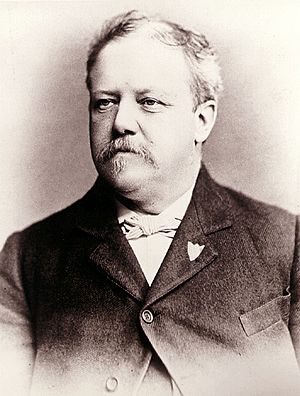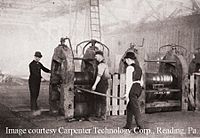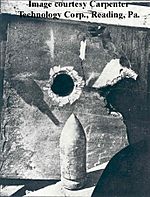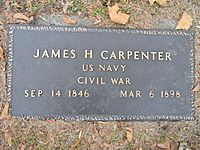James Henry Carpenter facts for kids
Quick facts for kids
James Henry Carpenter
|
|
|---|---|

James Henry Carpenter
|
|
| Nickname(s) | Henry |
| Born | September 14, 1846 New Jersey |
| Died | March 6, 1898 (aged 51) Reading, Berks County, Pennsylvania |
| Place of burial |
Charles Evans Cemetery, Reading, Berks County, Pennsylvania
|
| Allegiance | |
| Service/ |
|
| Years of service | 1861–1865 |
| Rank | Master's mate and Midshipman |
| Battles/wars | American Civil War |
| Other work | Founder of Carpenter Steel Company, renamed in 1968 Carpenter Technology Corporation. |
James Henry Carpenter (September 14, 1846 – March 6, 1898) was an American engineer and businessman. He started the Carpenter Steel Company, which later became Carpenter Technology Corporation. When he was just 15, he joined the Union Navy as a cabin boy during the American Civil War. He was wounded in battle but showed great bravery. Because of his good actions, he was promoted to master's mate. At 16, he was accepted into the United States Naval Academy. He left the Navy in 1865 and studied engineering.
In 1889, he founded the Carpenter Steel Company in Reading, Pennsylvania. Under his leadership, the company became a key supplier of strong metal plates and weapons for the U.S. Navy.
Contents
Early Life and Dreams
James Henry Carpenter was born in New Jersey on September 14, 1846. His parents were William H. Carpenter and Elizabeth Wallace. James was the oldest of five children. As a child, he spent time on Long Island, New York. He loved sailing ships and figuring out how things worked. He learned to sail small boats and dreamed of becoming a sailor. At 14, with his father's permission, he went to sea as a cabin boy.
Serving in the Civil War
In May 1861, when the American Civil War began, 15-year-old James joined the Union Navy. He was assigned to the USS Santee, a large 44-gun warship. The Santee went to the Gulf of Mexico to help with the Union Blockade, which stopped enemy ships from getting supplies.
Carpenter was part of several important missions. He was there when the Santee captured two Confederate ships. He also joined a secret night mission to capture an enemy steamboat. The mission changed targets and they captured a picket boat called the Royal Yacht. Carpenter was wounded during this brave action and was praised for his courage.
By the end of 1861, Carpenter was made an acting master's mate on the Santee. This was a position for experienced sailors. In February 1862, he was officially appointed master's mate and moved to the flagship, USS Niagara. Soon after, he joined the steamer USS R. R. Cuyler and helped capture more enemy ships.
His captain noticed his excellent work and suggested he try to get into the United States Naval Academy. Carpenter left the R. R. Cuyler in September 1862 and was discharged as a sailor in November. The very next day, he was appointed a midshipman.
The U.S. Naval Academy had moved to Newport, Rhode Island, during the Civil War. Carpenter started there in December 1862, at age 16. He lived and studied on school ships like the Constitution and the Santee. He did well in his studies, especially in science. However, he often got into trouble for breaking rules, which led to extra duties.
In August 1865, Carpenter sailed back to the Naval Academy's original home in Annapolis, Maryland. The rules there were very strict. This was a tough change for many young cadets, including Carpenter, who continued to get demerits. At the end of his third year, he decided to leave the academy. He was honorably discharged in December 1865, when he was 19.
Family Life and Engineering
After leaving the Navy, Carpenter went to an engineering college in New Jersey. While studying, he met Theodora Anna Silvera. They married in December 1867. They lived in Paterson, New Jersey, where their first two children, Serena and Walter, were born. Carpenter became an engineer who worked with metals.
Later, the family moved to Brooklyn, New York, where their children Ruth and Joseph William were born. Around 1880, they moved to Hartford, Connecticut. Theodora passed away in 1883. Carpenter later moved to Chicago for engineering work. There, he met Georgian Clara Smith, and they married in July 1884. They had a daughter, Georgette, and later two sons, Harry Rudolph and Wesley Folger.
Starting Carpenter Steel Company
In late 1887, Carpenter traveled to Europe to study steel factories and how steel was made. He developed new and better ways to process steel. He returned home in December 1888, looking for money to start his own business. He found support from investors in New York. The city council in Reading, Pennsylvania, also encouraged him, and he decided Reading was the perfect place for his new company.
The Carpenter Steel Company, Inc. officially started on June 7, 1889. Carpenter became its general manager. He rented an old rail mill in Reading. Just eleven weeks later, he was already making steel for tools. Soon, the company was getting more orders than it could handle. Carpenter then bought and updated a nearby factory called Union Foundry. Today, this old factory is the main office of the Carpenter Technology Corporation, which still makes special steel.
Carpenter cared about his employees. He made sure they had good working conditions and benefits. The company even had health clinics and sports fields for workers. This approach was so good that employees chose not to join unions, preferring to work directly with the company.
Carpenter bought a house in Reading and became involved in his community. He joined groups for Civil War veterans. Through these connections, he learned that the U.S. Navy needed special steel.
Benjamin F. Tracy, the Secretary of the Navy, wanted to build a "New Navy" with modern warships. These new ships needed stronger steel for their armor and powerful projectiles to break through enemy armor. In May 1890, Carpenter Steel signed a contract to provide special tool steel. More contracts followed for armor-piercing projectiles.
Carpenter developed a special way to treat steel, making it very hard. He applied for a patent for his "Apparatus for treating Ingots of Steel" in 1895, and it was finally approved in 1900.
The USS Indiana, the first modern U.S. battleship, was launched in 1895. While it didn't use Carpenter's steel for its main armor, tests showed that Carpenter's projectiles were incredibly strong. They could pierce much thicker armor than other projectiles. In 1896, the Navy told Congress that Carpenter's projectiles were the first that could break through improved armor plates.
When the USS Maine exploded in Cuba in February 1898, the demand for Carpenter's projectiles skyrocketed. "Remember the Maine!" became a famous rallying cry, and Carpenter Steel worked tirelessly. Carpenter even borrowed money to increase production. However, the Navy's payments were often late, causing financial stress for the company.
Carpenter and the company's board had some disagreements in late 1897 due to rising debts and costs. Carpenter offered to step down as general manager, which was accepted in March 1898.
The armor-piercing projectiles used during the Spanish–American War of 1898, which helped defeat the Spanish fleets, were made by Carpenter Steel. The company received many letters praising their projectiles.
Death and Lasting Impact
James Henry Carpenter never saw the letters praising his steel. In February 1898, he worked very long hours. He caught a cold but kept walking to and from the factory, even in the rain. By early March, he was very sick and died on March 6, 1898, at age 51, from pneumonia. He was buried in Charles Evans Cemetery in Reading.
After his death, his house and belongings were sold to pay off debts. His wife and children faced financial difficulties. She received a pension from the U.S. Government starting in 1904.
In early 1899, after the Spanish–American War ended, the U.S. Navy canceled its contracts because they had too many projectiles. The company struggled for a few years. In 1903, a marketing expert named Robert E. Jennings took over and helped turn the company around. He became president in 1904 and led the company through many years of new ideas. Carpenter's special steel was used in the early airplanes of the Wright brothers and Glenn Curtiss. Today, it is still used in many high-performance machines.
Images for kids










